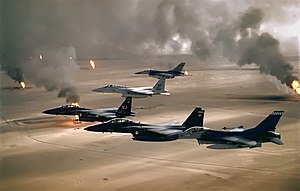
Back الحملة الجوية في حرب الخليج الثانية Arabic Campaña aérea de la Guerra del Golfo Spanish نبرد هوایی جنگ خلیج فارس Persian Campagna aerea della guerra del Golfo Italian
| Gulf War air campaign | |||||||
|---|---|---|---|---|---|---|---|
| Part of the Gulf War | |||||||
 USAF F-16A, F-15C & F-15E aircraft fly over burning oil fields in Kuwait | |||||||
| |||||||
| Belligerents | |||||||
|
|
| ||||||
| Commanders and leaders | |||||||
|
|
| ||||||
| Strength | |||||||
| Over 2,780 fixed-wing aircraft[1] | 1,114 fixed-wing aircraft (550 combat aircraft), numerous air defence systems | ||||||
| Casualties and losses | |||||||
|
46 killed or missing 8 captured 75 aircraft ‒ 52 fixed-wing aircraft and 23 helicopters |
10,000–12,000 killed[2] 254 aircraft lost on the ground[3] 36 aircraft shot down in air-air combat several air defense systems | ||||||
| 2,000–3,000 Iraqi civilians killed | |||||||
The Gulf War of 1990–1991 included an air campaign, as the air forces of the coalition carried out an extensive aerial bombing campaign from 17 January 1991 to 23 February 1991 against Iraq. Spearheaded by the United States, the coalition flew over 100,000 sorties, dropping 88,500 tons of bombs,[4] widely destroying military and civilian infrastructure.[5] The air campaign was commanded by United States Air Force (USAF) lieutenant general Chuck Horner, who briefly served as Commander-in-Chief—Forward of U.S. Central Command while general Norman Schwarzkopf was still in the United States. The British air commanders were Air Vice-Marshal Andrew Wilson (to 17 November 1990) and Air Vice-Marshal Bill Wratten (from 17 November).[6] The air campaign had largely finished by 23 February 1991 when the coalition invasion of Kuwait took place.
The initial strikes were carried out by Tomahawk cruise missiles[7] launched from U.S. Navy warships situated in the Persian Gulf, by F-117A Nighthawk stealth bombers[7] with an armament of laser-guided smart bombs,[7] and by F-4G Wild Weasel aircraft as well as F/A-18 Hornet aircraft armed with HARM anti-radar missiles.[8] These first attacks allowed F-14 Tomcat, F-15 Eagle, F-16 Fighting Falcon, and F/A-18 Hornet combat aircraft to gain air superiority over Iraq and then continue to drop television-guided and laser-guided bombs.
Armed with a GAU-8 rotary cannon and infrared-imaging or optically guided Maverick missiles, USAF A-10 Thunderbolt II's bombed and destroyed Iraqi armored forces,[7] supporting the advance of U.S. ground troops. United States Marine Corps close air support AV-8B Harriers employed their 25mm rotary cannon, Mavericks, cluster munitions, and napalm against the Iraqi dug-in forces to pave the way forward for the U.S. Marines breaching Iraqi president Saddam Hussein's defenses. The U.S. Army AH-64 Apache and AH-1 Cobra attack helicopters fired laser-guided Hellfire missiles and TOW missiles which were guided to tanks by ground observers or by scout helicopters, such as the OH-58D Kiowa.[9] The Coalition air fleet also made use of the E-3A Airborne Warning and Control Systems and of a fleet of B-52 Stratofortress bombers.[7][8]
- ^ Cite error: The named reference
CPGWIVIIIpg221was invoked but never defined (see the help page). - ^ Keany, Thomas; Eliot A. Cohen (1993). Gulf War Air Power Survey. United States Dept. of the Air Force
- ^ https://www.afhra.af.mil/Portals/16/documents/Airmen-at-War/Haulman-WhatHappenedIraqiAF.pdf?ver=2016-08-22-131410-023#:~:text=During%20Operation%20DESERT%20STORM%2C%20the,open%2C%20and%20141%20in%20shelters. [bare URL PDF]
- ^ Allen; Thomas, Berry F; Polmar, Norman (1991), War in the Gulf, Turner, p. 147.
- ^ Operation Desert Storm, Global security.
- ^ "No. 52589". The London Gazette (Supplement). 28 June 1991. p. 46.
- ^ a b c d e Boyne (2003), pp. 359, 360
- ^ a b Gross (2002), pp. 226–7
- ^ Gross (2002), p. 235.
© MMXXIII Rich X Search. We shall prevail. All rights reserved. Rich X Search